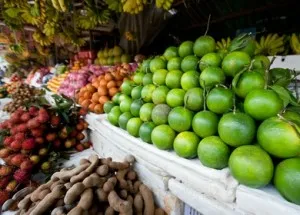There is not a fresher sight than a roadside fruit and veggie stand bursting with color and freshness. Produce, picked from the vine just hours earlier, drips with ripeness and wholesome nutrition.
The local movement is in full swing in America. The United States Department of Agriculture noted that the number of farmers markets in the United States increased over 50% between 2008 and 2011.
As the wave of enthusiasm for local living begins to take hold, we see a return to what was once important in America. Shaking the hand of those who feed us, knowing our neighbors, spending our hard earned dollar within our own communities and a return to “Front Porch America, ” is what it is all about.
Having an option to shop locally, especially for food has many advantages over doing the supermarket shuffle.
Locally Grown Food Tastes Great: Crops are picked at their peak of freshness and don’t have to travel hundreds of miles to their destination. Freshly-picked produce retains its natural flavor and requires no chemicals for preservation.
Locally Grown Food is Highly Nutritious: Most produce purchased at the local grocery store has travelled between 1,500 and 4,000 miles according to the Organic Consumer Organization. Not only does this make our food system vulnerable but it also reduces nutrient value.
Some produce has little to no nutrient value by the time it reaches our tables because of the distance it has travelled. Local food has a shorter time from harvest to table, usually 24 hours at most, and this preserves nutrients.

Local Food is Safer: With a shorter distance to travel, there is a great reduction in the chance of contamination when we eat locally. Issues with safety often occur in storage and transportation; when food goes from vine to table the risk is substantially minimized.
Eating Local is Healthy for the Environment: Buying as much food as you can locally helps the environment. It decreases the use of packages including foam and plastic trays and wraps and cuts down on greenhouse gases used in production and transportation of food. In many cases, it takes more energy to transport food than the food provides.
The Organic Consumers Organization gives the example of a head of lettuce produced in Salina Valley California that travels some 3,000 miles to Washington, D.C. The transportation requires 36 times as much fossil fuel energy as the food itself produces when it arrives in Washington.
Are you living local?
-The Alternative Daily
